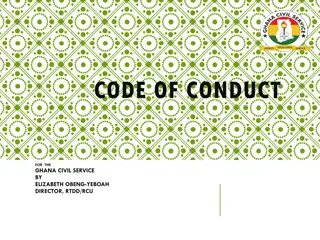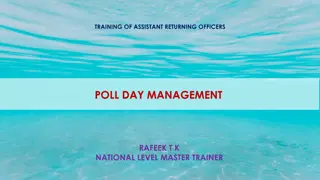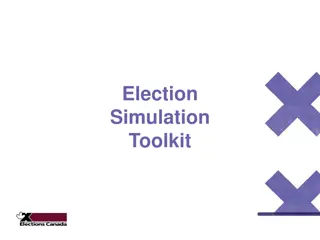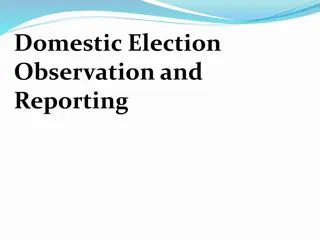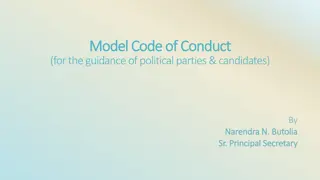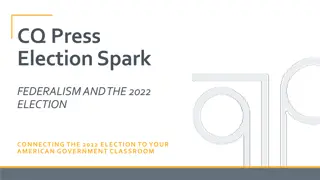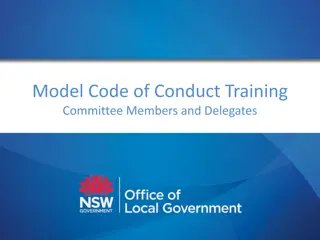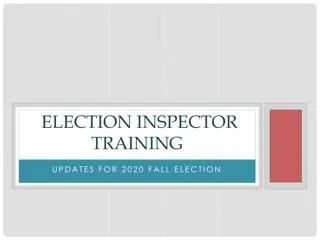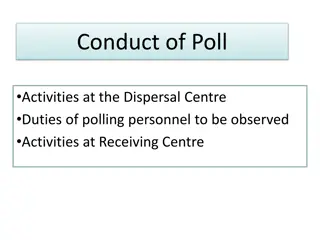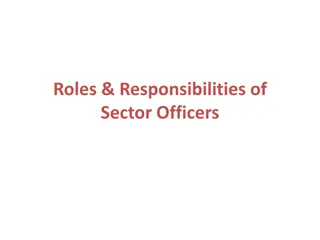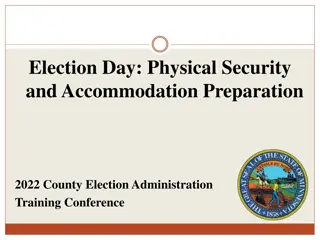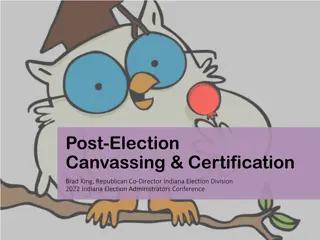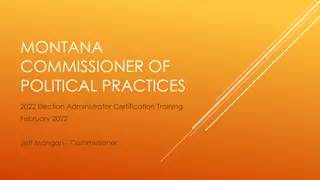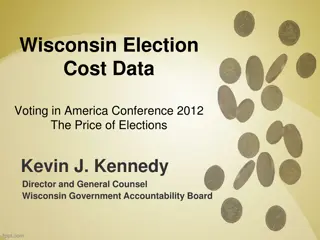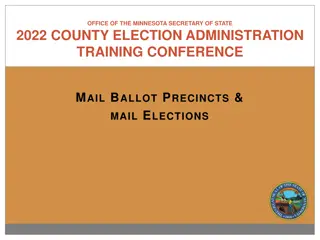2024 Election Judge Training: Code of Conduct, Neutrality, and Polling Place Setup
Explore the essentials of election judge training for the 2024 elections, covering the code of conduct, maintaining neutrality in the polling place, and details on polling place setup and roles. Understand the oath, duties, and responsibilities of an election judge, emphasizing impartiality, professionalism, and serving diverse populations effectively.
Download Presentation

Please find below an Image/Link to download the presentation.
The content on the website is provided AS IS for your information and personal use only. It may not be sold, licensed, or shared on other websites without obtaining consent from the author.If you encounter any issues during the download, it is possible that the publisher has removed the file from their server.
You are allowed to download the files provided on this website for personal or commercial use, subject to the condition that they are used lawfully. All files are the property of their respective owners.
The content on the website is provided AS IS for your information and personal use only. It may not be sold, licensed, or shared on other websites without obtaining consent from the author.
E N D
Presentation Transcript
2024 2024 ELECTION JUDGE TRAINING June, 2024
Training Agenda Training Agenda Code of Conduct Polling Place Set-Up Opening the Polls Election Judge Duties Polling Place Conduct Providing Assistance to Voters Challengers Closing the Polls
Election Judge Code of Conduct Election Judge Code of Conduct You will take and sign this oath: I solemnly swear (or affirm) that I will perform the duties of election judge according to law and the best of my ability and will diligently endeavor to prevent fraud, deceit and abuse in conducting this election. I will perform my duties in a fair and impartial manner and not attempt to create an advantage for my party or any candidate. M.S. 204B.24
What does the code of conduct look like in What does the code of conduct look like in practice? practice? Be impartial, courteous and professional Maintain your polling place s accessibility, neutrality, and efficiency Enjoy assisting and serving diverse populations Stay positive!!
Election Judge Neutrality in the Polling Place Election Judge Neutrality in the Polling Place Voters have the right to vote in a polling place that is free of any influence. Remember your Oath: I will perform my duties in a fair and impartial manner and not attempt to create an advantage for my party or my candidate.
Polling Place Set Polling Place Set- -Up Up - - Overview Overview Polling Place Judges: Head Judge (a/k/a Chairperson or Chair) Greeter Judge Roster Judge Registration Judge Demonstration Judge Ballot Judge Ballot Counter Judge (Ballot Counter a/k/a DS200 or Voting Machine/Tabulator)
Head Judge (Chairperson): Duties Head Judge (Chairperson): Duties Lead official in the polling place Oversees polling place setup and ensures supplies are ready before opening Administers the election judge oath Conducts emergency judge training for replacement judges Reviews news media credentials Conducts the challenge process Resolves questions and problems Completes election returns and other forms Closes the polling place and returns materials
Polling Place Set Polling Place Set- -Up and Guidance for Equipment Up and Guidance for Equipment OMNI-BALLOT (Assisted Voting Device) Provides privacy and independence to voters who cannot, or choose not, to vote using a pen Displays the ballot in large print or with a high-contrast background Can read the ballot to the voter through headphones Test your device! Compare paper ballot to offices and candidates displayed on the screen. Ensure the audio works. Make the station private and wheelchair accessible.
Polling Place Set Polling Place Set- -Up Up - - Preparing Ballots Preparing Ballots Record the total number of ballots provided in packets. M.S. 204C.09, subd. 1(a) Open an initial supply of packets and verify quantity Two judges initial each ballot. M.S. 204C.09, subd. 1(b) Call before you are about to open the 2ND TO LAST pack AND AGAIN, when you get to the last pack, if necessary.
Polling Place Set Polling Place Set- -Up and Guidance: Opening the Polls Up and Guidance: Opening the Polls Polling place opening and voting MUST begin on time. If the Omni-Ballot is not working, contact the City Clerk s Office immediately. If the DS-200 is not working, use the auxiliary slot on the ballot box and contact the City Clerk s Office immediately.
Roster Steps at the Roster Table Roster Steps at the Roster Table Ask for name and address Voter may hand you an ID to assist with locating their name this is voter s choice and not required. Clarify verbally an ID not necessary so that those nearby are not confused. Check page for roster notations, (e.g. See ID ) Hide Challenges from view except any Challenge for that voter Point to the oath and have them sign Give voter receipt and direct to Ballot Judge station Voters should wait their turn at least 6 feet away from the table to protect voter privacy
Roster Notations Roster Notations Address
Common Roster Notations Common Roster Notations A.B. or Absentee Ballot Voter has already cast an absentee ballot and cannot vote again in person See ID Must show Election Day Registration (EDR) documentation Challenged Postal Return (postal verification card was returned) Challenged Voted Out of Precinct (provide proof of residence) Challenged Address (residency in question) Challenged Guardianship (court-ordered guardianship)
Go to Registration Table If Go to Registration Table If Submitted registration application less than 20 days before election Has not voted in past 4 years On roster but had legal name change Changed addresses within the precinct Even if they have moved to a new apartment within the same building
Cant find a voters name? Can t find a voter s name? Is the voter at the wrong precinct? Did the voter move out of the precinct? Was the voter s name was left off due to clerical error? See Emergency Voting Procedures as per M.R. 8200.3800 / Call the City Clerk s Office Does the voter s name, address or date of birth on the roster contain a clerical error? Roster correction form If you need assistance, call the Clerk s Office
Roster Tips Roster Tips The roster is a legal document that indicates a voter received and cast a ballot Maintain it carefully DO NOT REMOVE PAGES*! Keep the roster free of unnecessary handwriting Avoid using an x to identify where a person should provide their signature Use Roster Correction Forms or Certification Statement of Deceased Voter to note changes/corrections to roster
Registration Steps Registration Steps 1. Use precinct finder to verify voter is at right polling place 2. Confirm voter has not already voted absentee A list of AB voters will be with your materials 3. Complete a registration application 4. Confirm proof of residence 5. Complete EJ official use only section on bottom 6. Have voter read oath on the Election Day Registration roster page 7. Have voter complete and sign the Election Day Registration Roster 8. Hand them a voter receipt
Election Day Registration (EDR or VRA) Application Election Day Registration (EDR or VRA) Application
Official Use Only Section Official Use Only Section
Eligibility Eligibility A U.S. citizen At least 18 years old on Election Day (may register if at least 16, but cannot vote) A resident of Minnesota (NOT a specific precinct) for 20 days A person can vote while under guardianship unless a judge specifically has revoked their right to vote. A person cannot vote if a court has ruled that they are legally incompetent A criminal record does not impact your right to vote unless you are currently incarcerated for a felony conviction
What are the valid forms of proof of residence acceptable for Election Day registration?
1. ID With Current Name And Address 1. ID With Current Name And Address Current Minnesota driver s license, learner s permit or ID card Receipt for a Minnesota driver s license, learner s permit or ID card NOT required to show photo ID, receipt alone is sufficient (generally includes a picture now) Tribal ID with name, current address, signature and picture from federally recognized tribal government Valid Student ID if student lives on or in the same city as campus
2. Old or Expired ID and a Document With Address 2. Old or Expired ID and a Document With Address The ID can be expired The document can be a bill, account or start-of service statement, and must be due or dated within 30 days of the election. Student fee statement must be for current or next semester You can also show the document on a phone or other electronic device
2. Old or Expired ID and a Document With Address 2. Old or Expired ID and a Document With Address Approved old or expired photo ID: Driver s license, state ID or learner s permit issued by any state U.S. Passport U.S. Military or Veteran ID Tribal ID with name, signature and photo Minnesota university or college ID Minnesota high school ID
2. Old or Expired ID and a Document With Address 2. Old or Expired ID and a Document With Address Approved documents (Bills, Account Statements, and Start-of-Service Notifications): Phone (landline, cell, VOIP, etc.) TV (cable, satellite, etc.) Internet Solid waste or sewer Electric, gas or water Banking or credit card Rent or mortgage payments Residential lease or rent agreement valid through Election Day Current student fee statement
3. Vouching 3. Vouching ( (M.S. 201.061, M.S. 201.061, subd subd. 3(a)(4)) . 3(a)(4)) Voter registered in same precinct can sign an oath attesting to up to 8 new registrants residence Assisted living staff members may vouch for residents (includes adult foster care, residential treatment) Must personally know they live in the precinct Voucher can also register on Election Day, except by vouching if they are vouched for, they cannot vouch for others Complete voucher form on backside of application New clarifying language for voucher form: Use this form only if you are registering to vote with a voucher as your proof of residence. Note on tracking sheet (Precinct List of Persons Vouching form)
3. Vouching 3. Vouching ( (M.S. 201.061, M.S. 201.061, subd subd. 3(a)(4)) . 3(a)(4))
4. Notice of Late Registration 4. Notice of Late Registration If you registered to vote within 20 days of the election, you may get a Notice of Late Registration in the mail It can be used as a proof of residence
5. 5. Valid Registration in the Same Precinct Valid Registration in the Same Precinct If a voter is currently registered in the precinct but changed names or moved within the same precinct, their registration serves as proof of residence no additional documentation is needed Find voter s name on roster and copy their voter ID number in the other section on the bottom of the registration application
6. 6. Student ID with College List Student ID with College List Precinct may be provided with a list of students housed at a Minnesota college or university Students on list can register by showing a current, valid student photo ID
Dont Forget to Don t Forget to Document proof of residence provided on bottom of voter registration application Have voter complete and sign new registrant roster page Provide voter receipt and direct to demonstration or ballot judge Keep running total of persons unable to provide proof of residence
Spoiled and Found Ballots Spoiled and Found Ballots Spoiled ballot Exchange for new ballot and put into spoiled ballot envelope Found ballot (ballot found abandoned somewhere) Mark found in booth on ballot and put in spoiled ballot envelope Record on incident log
DS DS- -200 Errors 200 Errors DS200 will beep and return the ballot if: Voted for more candidates than is allowed for an office Voted for candidates from more than one party in a State Primary Voter may get new ballot, or you can override the error to vote ballot as is If DS-200 Stops Working: Open auxiliary slot on ballot box and contact the City Clerk s Office Voting continues without interruption When counter is working, but ballots in auxiliary slot into ballot counter.
Polling Place Conduct Polling Place Conduct Incident Log: Lets officials know what occurred in the precinct Record ANY and ALL unusual events or problems Record how problems were resolved MUST BE returned to clerk with precinct supplies!!
Persons Allowed In or Near the Polling Place Persons Allowed In or Near the Polling Place ( (M.S. 204C.06 Only election judges, people directly engaged in voting, and authorized persons can be present Persons helping a voter Children accompanying voters Vouchers Observers with written authorization from the secretary of state, county auditor or clerk Peace officers, if judges request their presence to keep order Challengers appointed in writing by a political party or nonpartisan candidate Teachers and elementary/high school students, if participating in a mock election that has been authorized by the secretary of state Persons making a written complaint Media with proper credentials People conducting exit polls can be on the premises, but not in the room where voting occurs If an election judge is present who is NOT assigned to your precinct, call the Clerk s Office immediately. M.S. 204C.06) )
Media Media Must present photo ID to the Head Judge and either: - Media credential - Written statement from a local election official Cannot: - Approach within 6 ft. of someone voting - Converse with voter while in the polling place - Make a list of persons voting or not voting - Interfere with the voting process
Prohibition on Campaigning Prohibition on Campaigning No campaigning or lingering in or within 100 feet of the building If polling place is on public property, campaigning not allowed anywhere on the property, even beyond 100 feet Does not apply to adjacent private property
Prohibition on Displaying Campaign Materials Prohibition on Displaying Campaign Materials MN Voters Alliance v. Mansky Minnesota law prohibits a person from displaying campaign material or inducing or persuading a voter in the polling place. Campaign material includes: the name, likeness, logo, or slogan of a candidate who appears on the ballot; the number, title, subject, slogan, or logo of a ballot question that appears on the ballot; or, the name, logo, or slogan of a political party represented by a candidate on the ballot.
Prohibition on Displaying Campaign Materials Prohibition on Displaying Campaign Materials If a person is displaying campaign material DO THE FOLLOWING: Explain that state law prohibits displaying campaign material or inducing or persuading voters in the polling place Ask the individual to cover up or remove the material, or to refrain from inducing or persuading other voters If they refuse, explain that eligible voters will be allowed to vote, but any refusal will be recorded and referred to the appropriate authorities.
Prohibition on Displaying Campaign Materials Prohibition on Displaying Campaign Materials EVEN IF A VOTER REFUSES TO COVER UP OR LEAVE YOU MUST PERMIT AN ELIGIBLE VOTER TO VOTE!! Record the names and addresses of a voter with a brief description of the campaign material or they way the voter was inducing or persuading another voter Election judges and official challengers are prohibited from displaying campaign material, inducing or persuading voters. You can ask them to leave if they refuse to remove the material, or to stop inducing or persuading.
Security Practices EJs are the 1st Line of Defense for physical & cyber security of Minnesota s elections! Watchful throughout election day: All voting equipment Removable memory devices Ballots Supplies Anything suspicious & all incidents, communicated to the local election official immediately
Security Practices Good practice to: View & inspect seals on all port plugs on all equipment & ballot storage containers. Take seriously voter reports of email, text, social media, phone or other communications attempting to disrupt or spread misinformation about the voting process. Report to the local election official, immediately, any and all items related to election security!
Security Practices Sergeant-at-arms or peace officer: May be requested to arrest or remove from the polling place any individual who, despite a warning to desist, engages in disorderly conduct, to include tampering with voting equipment.
Security Practices Sergeant-at-arms or peace officer: Shall not otherwise interfere in any manner with voters. A peace officer cannot remain in or within 50 feet of the entrance of the polling place once peace has been restored. Note the details of all security concerns & how they were addressed on the incident log
Providing Assistance to Voters Providing Assistance to Voters Do not influence how a person votes Direct questions to the voter, not others with them Help only as much as requested Two election judges of different major parties may mark a ballot according to voter s direction Suggest using the Omni-Ballot first Do not reveal how they voted
Interpreters and Assistance from Others Interpreters and Assistance from Others Voter may choose someone other than election judges for help Except an agent of their employer, their union or a candidate Assistants can help an unlimited number of voters in all aspects of the voting process, including marking ballots
Curbside Voting Curbside Voting (M.S. 204C.15, (M.S. 204C.15, subd subd. 2) . 2) Voter unable to enter polling place may vote from their vehicle Two election judges of different major parties bring voting materials to vehicle. Do not bring actual roster outside use the Certificate of Registered Voter form
Challengers: Contesting a Voters Eligibility Challengers: Contesting a Voter s Eligibility An election judge, any eligible voter in the precinct, or an appointed challenger may contest a voter s eligibility Must have personal knowledge that the person is not eligible to vote Suspicion is not a basis for making a challenge. Cannot challenge a voter s party preference
Challengers: Appointed Challengers Challengers: Appointed Challengers (M.S. 204C.07) (M.S. 204C.07) Appointed by nonpartisan candidates, political parties, or by jurisdiction holding election on a question Present letter of appointment and proof of residence used for Election Day registration Only 1 appointment per party/candidate per precinct
Challengers: Challenger Code of Conduct Challengers: Challenger Code of Conduct Must complete Oath of Challenge Form Cannot converse with voters Cannot make list of who voted Cannot handle election materials Cannot challenge party preference



